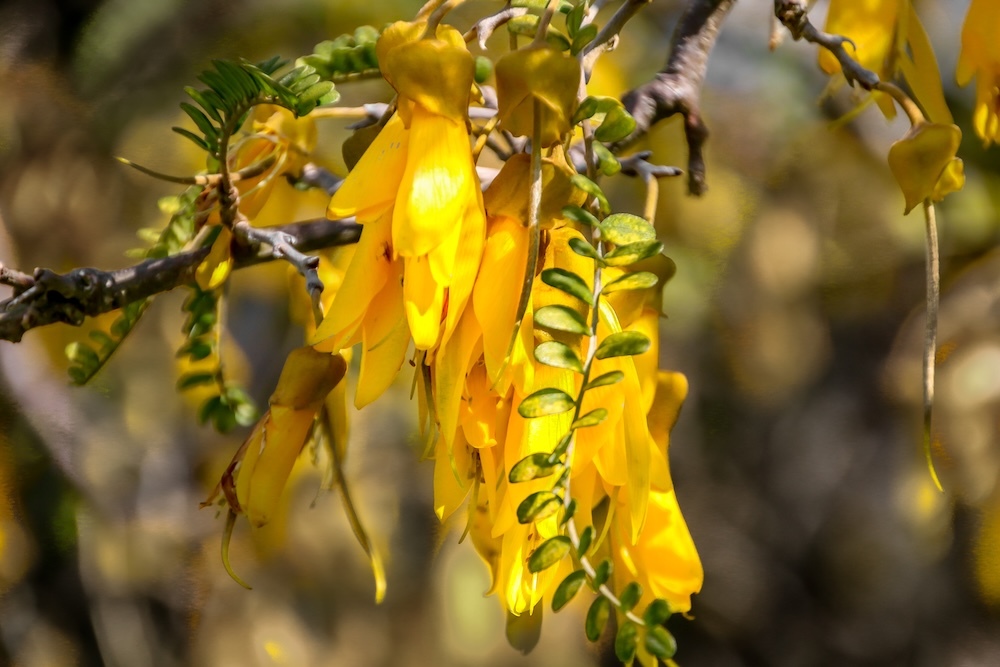learn: 5 facts about kōwhai trees
Native birds love their nectar
Native birds such as the tūī, korimako, kākā and kererū rely on kōwhai nectar as a seasonal food source. It is especially desirable to tūī who will fly vast distances to sample its tasty nectar. The kererū (New Zealand wood pigeon) loves to eat kōwhai leaves and its tender young leaf shoots.
There are 8 species of Kōwhai
All species are endemic to Aotearoa New Zealand, most of these species are trees except for two (Sophora molloyi and Sophora prostrata) which have bushy growth. Kōwhai trees can be found in Cornwall Park in the Native Arboretum, Twin Oak Drive and near the Archery Club. Species include Sophora microphylla, Sophora tetraptera, Sophora chathamica and Sophora prostrata.
1. Sophora chathamica: Known as the coastal kōwhai, this species thrives in coastal gardens and native plantings. It is often grown as a specimen tree and is particularly effective at attracting birds, making it a favourite among gardeners looking to enhance local wildlife habitats.
2. Sophora fulvida: This smaller variety of kōwhai is perfect for planting around living areas such as barbecue spaces. Its compact size and textural contrast make it an excellent companion for larger-leaved shrubs or fine-foliaged grasses, adding visual interest to any garden setting.
3. Sophora godleyi : Known as Goldies Mantle, this species features pea-like flowers and a semi-weeping form. Goldies Mantle brings a soft and elegant appearance to gardens.
4. Sophora longicarinata: This species is distinguished by its fine, dainty green foliage and bell-shaped flowers. Its delicate appearance adds a touch of grace to any garden.
5. Sophora prostrata: Also known as the dwarf kōwhai, this species boasts golden-colored, intertwined branches with very small leaves. Its compact and almost tangled form makes it suitable for bonsai.
6. Sophora microphylla: Juvenile trees of this species have tangled branches and can take up to 10 years to flower, but the wait is well worth it.
7. Sophora molloyi: Known as Dragons Gold, it has bright green foliage and pendulous clusters of flowers.
8.Sophora tetraptera: More commonly referred to as large-leaf kōwhai, this species has a slender and graceful growth habit.
The seeds are poisonous
All parts of the kōwhai are poisonous, especially the ripe yellow seeds. Because the seeds are hard, they require significant chewing to cause harm and must be consumed in large quantities to effectively poison a human. These seeds contain a toxin called Cytisine, which can lead to nausea and vomiting if ingested. It is important to handle kōwhai plants with care, especially if you have children or pets who might be tempted by the bright yellow seeds. Despite their toxicity, kōwhai trees are cherished in Aotearoa for their beautiful flowers, which attract a variety of native birds. These birds play a crucial role in pollinating the flowers, ensuring the continued survival of these endemic trees.

Kōwhai is used in Rongoā Māori (traditional Maori medicine)
Generations have utilized various parts of kōwhai for medicinal purposes. In Māori culture, kōwhai holds significant value, symbolizing strength and courage. The yellow flowers of the tree are employed in traditional Māori medicine to address various conditions like colds and skin infections.
Kōwhai grow in a diverse range of habitats
Kōwhai trees are a common sight across Aotearoa, gracing a variety of landscapes. These adaptable trees thrive in diverse environments, from coastal cliffs and lush forests to inland brush ecosystems. Propagation occurs through seeds, allowing kōwhai to mature into impressive trees reaching heights of up to 10 meters. Their extensive root systems play a crucial role in stabilizing riverbanks, which helps to minimize erosion and enhance water quality.
For those interested in cultivating kōwhai in their gardens, it's advisable to plant them in well-drained soil and a sunny spot to encourage healthy growth. Watching a Kōwhai tree bloom is a rewarding experience, as it bursts into a cascade of golden flowers, adding a touch of natural splendour to any landscape.
